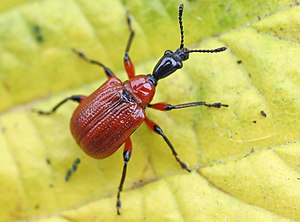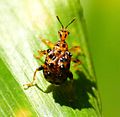Sheet roller
| Sheet roller | ||||||||||||
|---|---|---|---|---|---|---|---|---|---|---|---|---|

Hazel leaf roller ( Apoderus coryli ) |
||||||||||||
| Systematics | ||||||||||||
|
||||||||||||
| Scientific name | ||||||||||||
| Attelabidae | ||||||||||||
| Billberg , 1820 |
The leaf rollers or leaf moths (Attelabidae) are a family of beetles , they belong to the superfamily Curculionoidea . The family is delimited somewhat differently by different authors: some researchers consider the subfamily Rhynchitinae as an independent family Rhynchitidae. The Attelabidae include around 2100 species worldwide (as of 2004), around half of which belong to the Rhynchitinae. Their main area of distribution is in the tropics.
features
The beetles are four to eight millimeters long. They look very similar to the weevils , because they also have a rostrum (proboscis) that is more pronounced, however. The antennae are not kneeled. The legs are strongly developed (for slow walking). The feet are five-limbed, but the fourth limb is often indistinct. The undersides of the feet are densely hairy. The four-segmented maxillary palps are typical of the family (in most of the other Curculionoidea they are one or two-segmented). Most species are conspicuously colored (aposematic color or warning look), especially many Rhynchitinae are conspicuously metallic. The beetles almost always appear bald, and there is almost no thick hair or scales.
The species of the subfamily Apoderinae are unmistakable . Their temples are rounded and elongated like cheekbones on the head and the head is constricted neck-like towards the back.
Way of life
Both the beetles and the larvae feed on plants (phytophag). The food base is mainly the leaves of deciduous trees and shrubs. The Rosaceae , Fagaceae and Betulaceae are used particularly frequently , but there are species that specialize in a large number of other plant families. About two thirds of all species are monophagous on a single plant species or genus. Only a few species occur in numerous different plant species.
The beetles have developed exceptional brood care. The female cuts leaves so that they curl up. It lays its eggs in this role so that the larvae can develop protected. Some forms simply bite off the leaf, causing it to wither and sink to the ground. This behavior is considered to be the primitive form from which the sophisticated behavior of the sheet winder developed. In the subfamily Rhynchitinae there are also species that do not roll or fold the leaves. These species mostly live in fruit systems or buds. Few species live on herbaceous plants, in Central Europe z. B. Auletobius sanguisorbae on the Great Wiesenknopf . Very few, phylogenetically original species live on conifers.
The behavior of the leaf rollers was noted and described by many of the early naturalists, extensively by Jean-Henri Fabre e.g. B. in the poplar leaf roller ( Byctiscus populi ). The beetle selects a fully developed, but still soft leaf. It eats a niche in the petiole that cuts through most, but not all, of the vessels. The leaf begins to wither, it now hangs straight down. The beetle changes to the upper side of the leaf and grabs the leaf margins, which it grabs with its powerful claws and rolls inwards. He holds the sheet in the rolled position until its shape has adapted to the new position. The next layer of the roll is processed in the opposite direction to secure the part that has already been rolled. When the roll is finished, the beetle presses its trunk against the last lap until sticky gland secretion emerges from the leaf that fixes the lap. It takes about 24 hours to process such a cigar-shaped roll of leaves. One or more eggs are laid in each winding. Mating by the male takes place during the rolling process.
Most Attelabinae use a slightly different technique. They do not cut the petiole, but cut a cut perpendicular to the central vein through the basal part of the leaf blade. As a result, not the entire sheet but only its front part is converted into a roll. Depending on the species, only one side or both sides of the leaf blade is incised. Some shapes roll leaves without cutting them beforehand. The shape and shape of the leaf wrap is specifically different. In most species, the wilted leaf wrap sooner or later falls to the ground. The larva then usually pupates in a pupa cradle in the ground.
Some Attelabidae leave leaf rolling to relatives. The North American "thief weevil" Pterocolus ovatus is one of these kleptoparasites. He is looking for recently finished leaf wraps of Homoeolabus analis on oaks or chestnuts. Then he eats the egg of this species and lays his own egg in the leaf wrap. The larva then develops normally from the leaf substance.
Attelabidae usually have only one generation per year. A second generation is reported for only a few species.
Economic importance
Some species are considered to be agricultural or forestry pests, at least locally. It shall Rhynchites Bacchus as a dreaded pest in orchards.
Systematics
The Attelabidae family is one of the more original weevils with straight, non-kneeling antennae ("Orthoceri"). Possible sister groups are the Belidae or the Brentidae . While most taxonomists today prefer a broad delimitation of the family (including the Rhynchitinae), there are some who separate the Rhynchitinae as an independent family. Molecular studies based on homologous DNA sequences have partly supported the grouping of the Attelabinae with the Rhynchitinae, but partly achieved different results. The subfamily Apoderinae is believed to be closely related to the Attelabinae. The subfamily Pterocolinae, which is more closely related to the Rhynchitinae, does not occur in Central Europe.
In Central Europe the leaf rollers (without Rhynchitinae) are represented with only two genera and three species, in the whole of Europe there are only two subfamilies, two genera and six species. The Attelabidae were formerly part of the family of the weevils (Curculionidae).
Family Attelabidae (leaf roller)
Subfamily Apoderinae
- Hazel leaf roller ( Apoderus coryli ( Linnaeus , 1758))
- Apoderus erythropterus ( Gmelin , 1790)
Subfamily Attelabinae
- Oak leaf roller or oak ball weevil ( Attelabus nitens ) ( Scopoli , 1763)
- Attelabus sulcifrons ( Argod , 1895)
- Attelabus suturalis Jekel , 1860
- Attelabus variolosus ( Fabricius , 1801)
Subfamily Rhynchitinae
- Auletobius sanguisorbae ( cabinet , 1798)
- Byctiscus betulae ( Linnaeus , 1758)
- Byctiscus populi ( Linnaeus , 1758)
- Coenorhinus aeneovirens ( Marsham , 1802)
- Red-brown apple fruit cutter ( Coenorhinus aequatus ( Linnaeus , 1767))
- Strawberry weevil ( Coenorhinus germanicus ( Herbst , 1797))
- Coenorhinus interpunctatus ( Stephens , 1831)
- Coenorhinus pauxillus ( Germar , 1824)
- Deporaus betulae ( Linnaeus , 1758)
- Deporaus mannerheimi ( Hummel , 1823)
- Deporaus seminiger Reitter , 1880
- Deporaus tristis ( Fabricius , 1794)
- Lasiorhynchites cavifrons ( Gyllenhal , 1833)
- Lasiorhynchites coeruleocephalus ( Schaller , 1783)
- Lasiorhynchites olivaceus ( Gyllenhal , 1833)
- Lasiorhynchites praeustus ( Boheman , 1845)
- Lasiorhynchites sericeus ( autumn , 1797)
- Mecorhis ungarica ( autumn , 1784)
- Rhynchites aethiops Bach , 1854
- Rhynchites auratus ( Scopoli , 1763)
- Rhynchites bacchus ( Linnaeus , 1758)
- Rhynchites coeruleus ( Degeer , 1775)
- Rhynchites cribripennis ( Desbrochers , 1868)
- Rhynchites cupreus ( Linnaeus , 1758)
- Rhynchites giganteus Krynicki , 1832
- Rhynchites lenaeus Faust , 1891
- Rhynchites pubescens ( Fabricius , 1775)
- Temnocerus longiceps ( Thomson , 1888)
- Temnocerus nanus ( Paykull , 1792)
- Temnocerus tomentosus ( Gyllenhal , 1839)
Non-European species (selection)
- Euops chinensis
- Giraffe neck beetle ( Trachelophorus giraffa )
Picture gallery
Individual evidence
- ^ Brockhaus' Kleines Konversations-Lexikon . 11th edition. FA Brockhaus, Leipzig 1911 ( zeno.org [accessed on October 8, 2019] Lexicon entry “Blattroller”).
- ↑ a b A.A. Legalov (2005): Trophic Links of Leaf-Rolling Weevils (Coleoptera, Rhynchitidae and Attelabidae). Entomological Review, Vol. 85, No. 4: pp. 361-370. (Translated from Zoologicheskii Zhurnal, Vol. 84, No. 3, 2005, pp. 352-361.)
- ^ Jean-Henri Fabre (1922, orig. 1879): The life of the weevil. Translated by Alexander Teixeira de Mattos. Dodd, Mead & Co., New York.
- ↑ Hiromichi Kono (1930): The biological groups of the Rhynchitinen, Attelabinen and Apoderinen. Journal of the Faculty of Agriculture, Hokkaido Imperial University 29 (1): 1-36. download .
- ↑ Donald W. Hall & Lyle J. Buss (2007): Leaf-Rolling Weevil, Homoeolabus analis (Illiger) (Coleoptera: Attelabidae: Attelabinae) and Thief Weevil, Pterocolus ovatus Fabricius (Coleoptera: Rhynchitidae: Pterocolinae). document EENY-420 (IN753), series of Featured Creatures from the Entomology and Nematology Department, Florida Cooperative Extension Service, Institute of Food and Agricultural Sciences, University of Florida online .
- ^ Rolf G. Oberprieler, Adriana E. Marvaldi, Robert S. Anderson (2007): Weevils, weevils, weevils everywhere. Zootaxa 1668: 491-520.
- ↑ AA Legalov (2005): Reconstruction of the phylogeny of the Rhynchitids and Leaf-rolling Weevils (Coleoptera, Rhynchitidae, Attelabidae) Using the Synapse Method: Communication 2. Entomological Review, Vol 85, No.. 2: 131-136. Translated from Zoologicheskii Zhurnal, Vol. 84, No. 2, 2005, pp. 190-194.
- ↑ Anna K. Hundsdoerfer, Joachim Rheinheimer, Michael Wink (2009): Towards the phylogeny of the Curculionoidea (Coleoptera): Reconstructions from mitochondrial and nuclear ribosomal DNA sequences. Zoologischer Anzeiger Volume 248, Issue 1: 9–31. doi : 10.1016 / j.jcz.2008.09.001
- ↑ Attelabidae. Fauna Europaea, Version 1.3, April 19, 2007 , accessed on January 23, 2008 .




